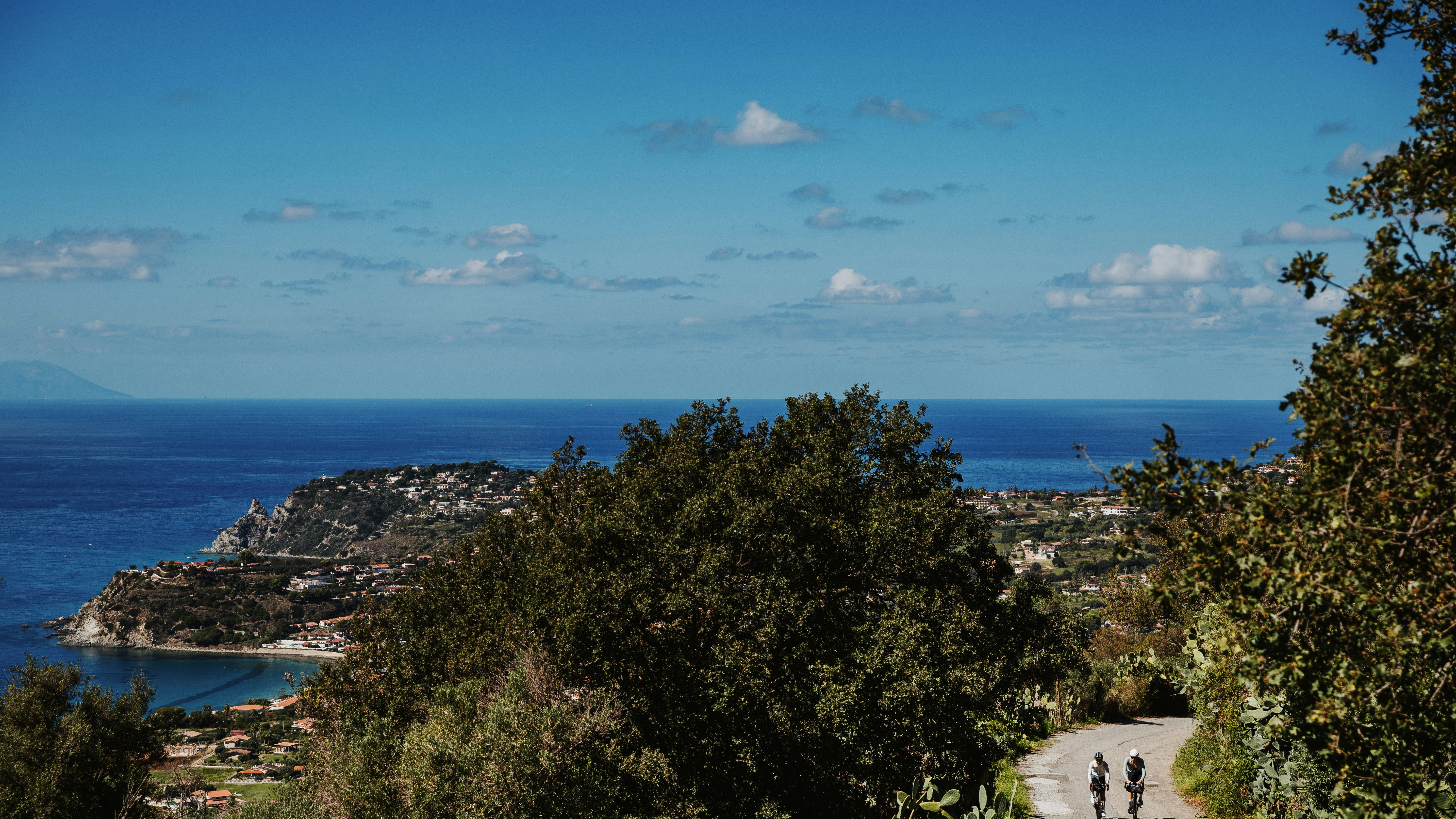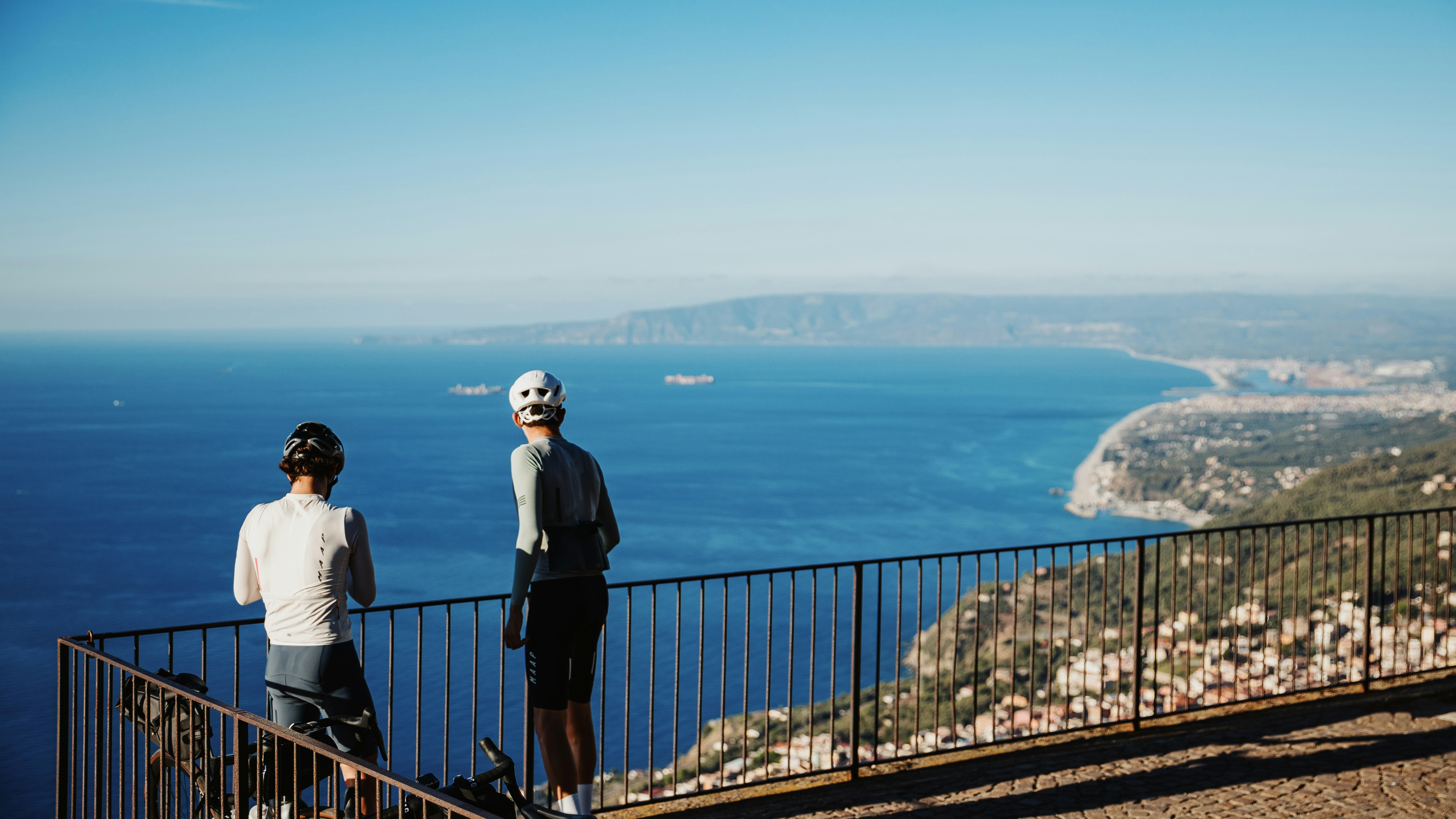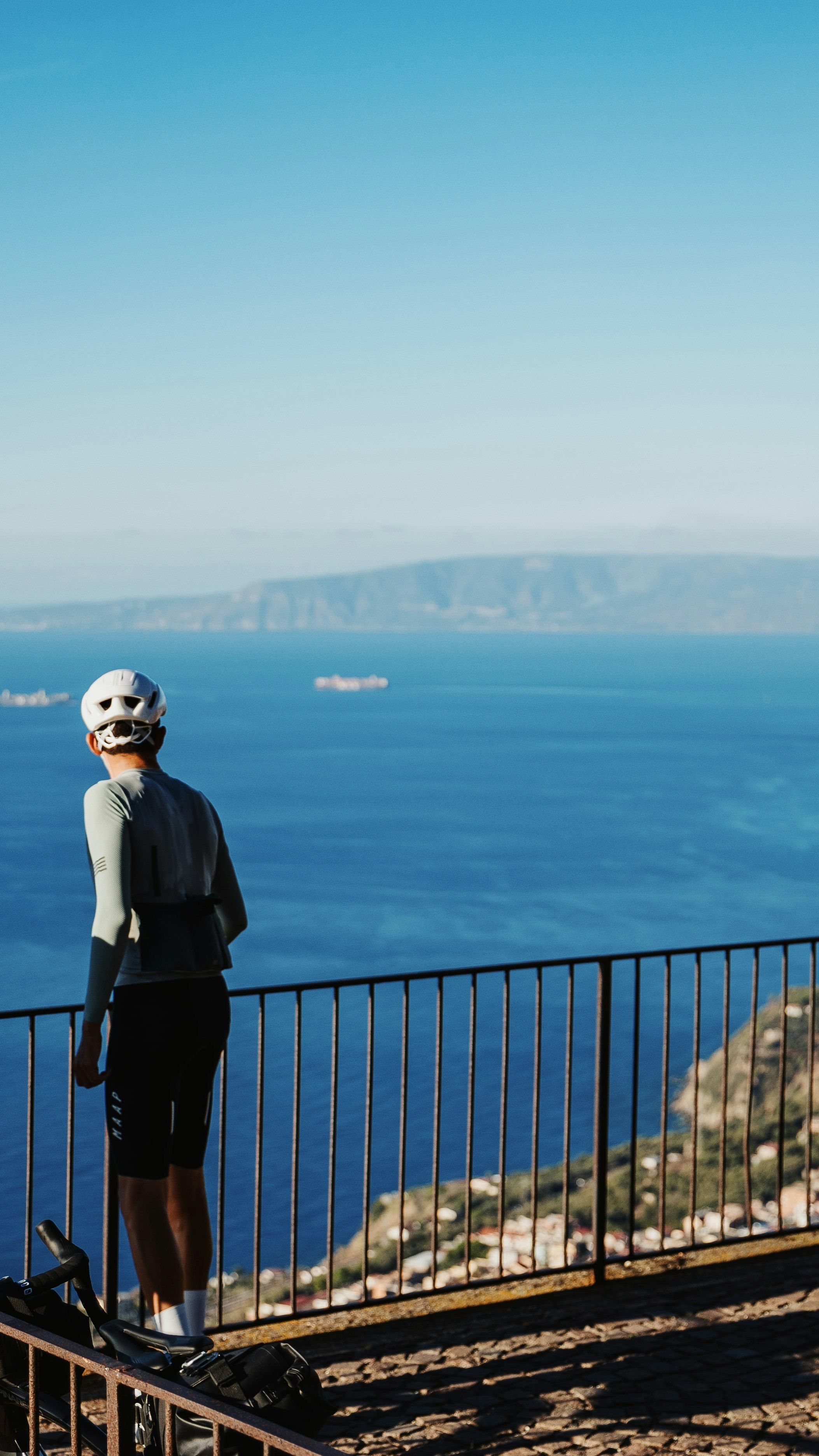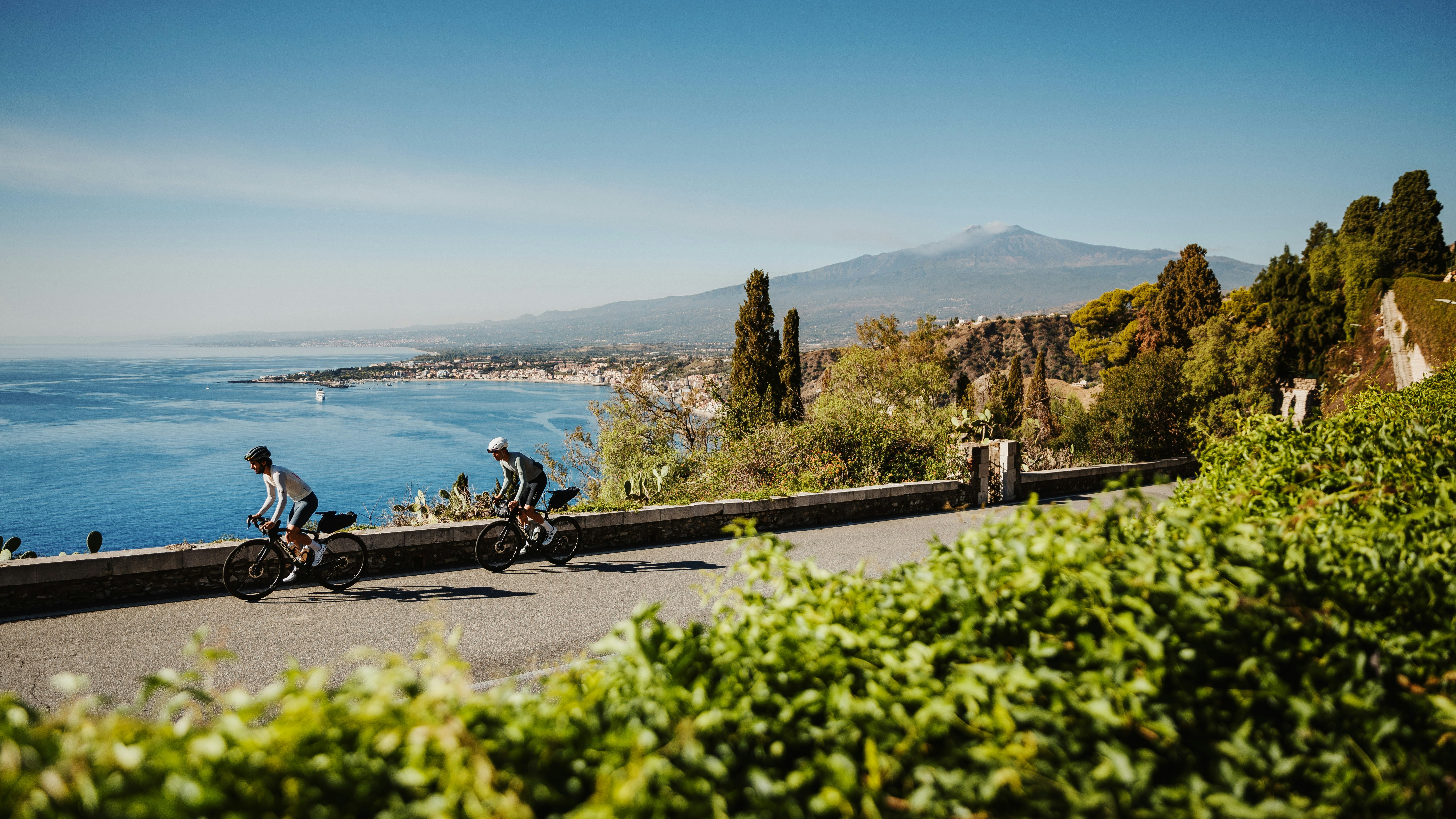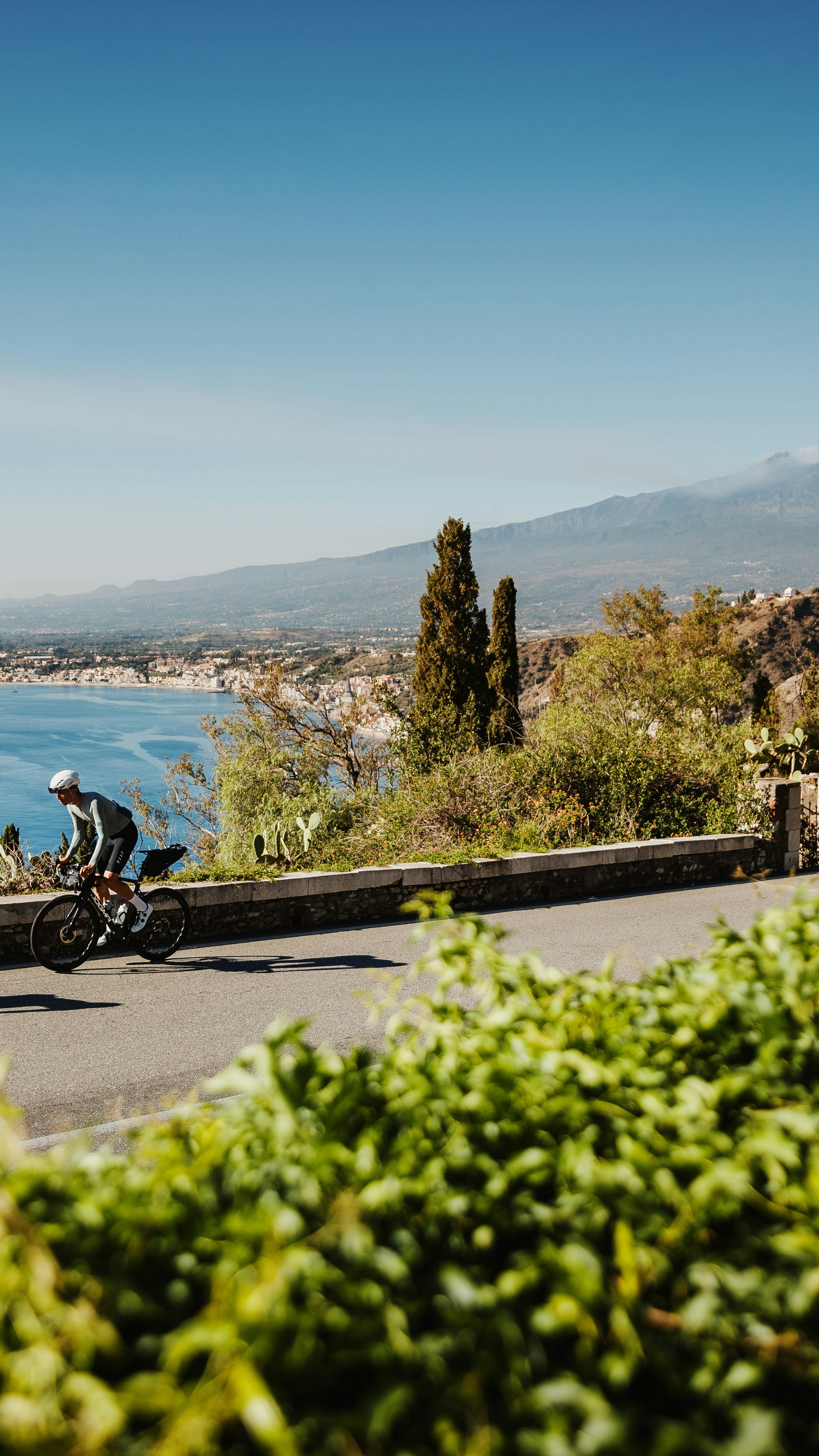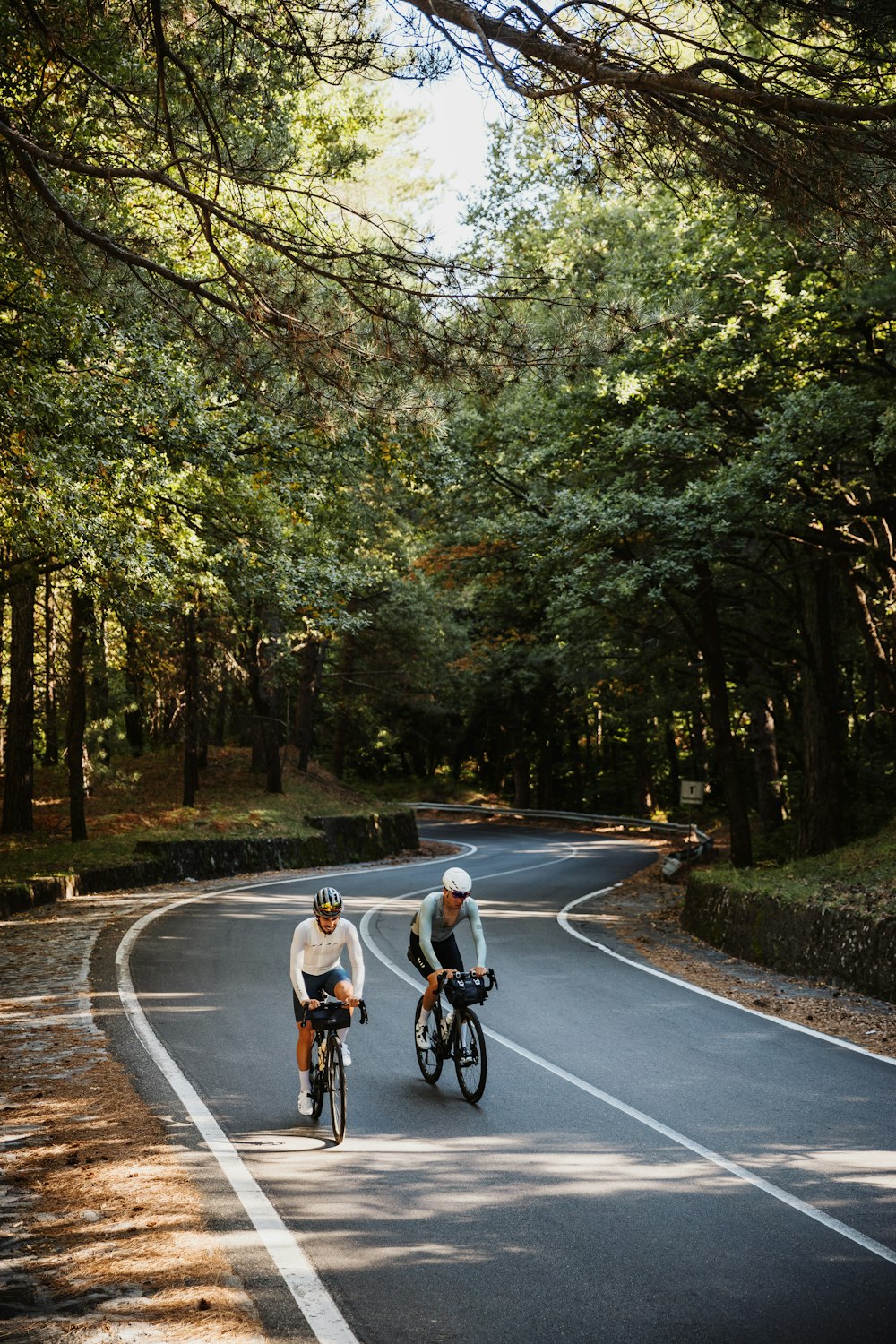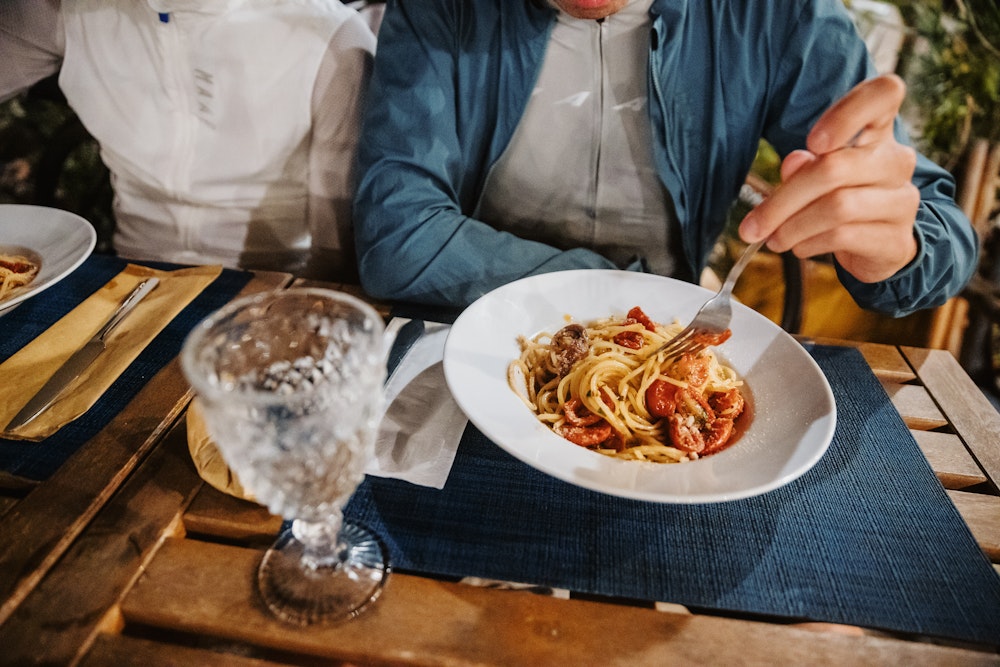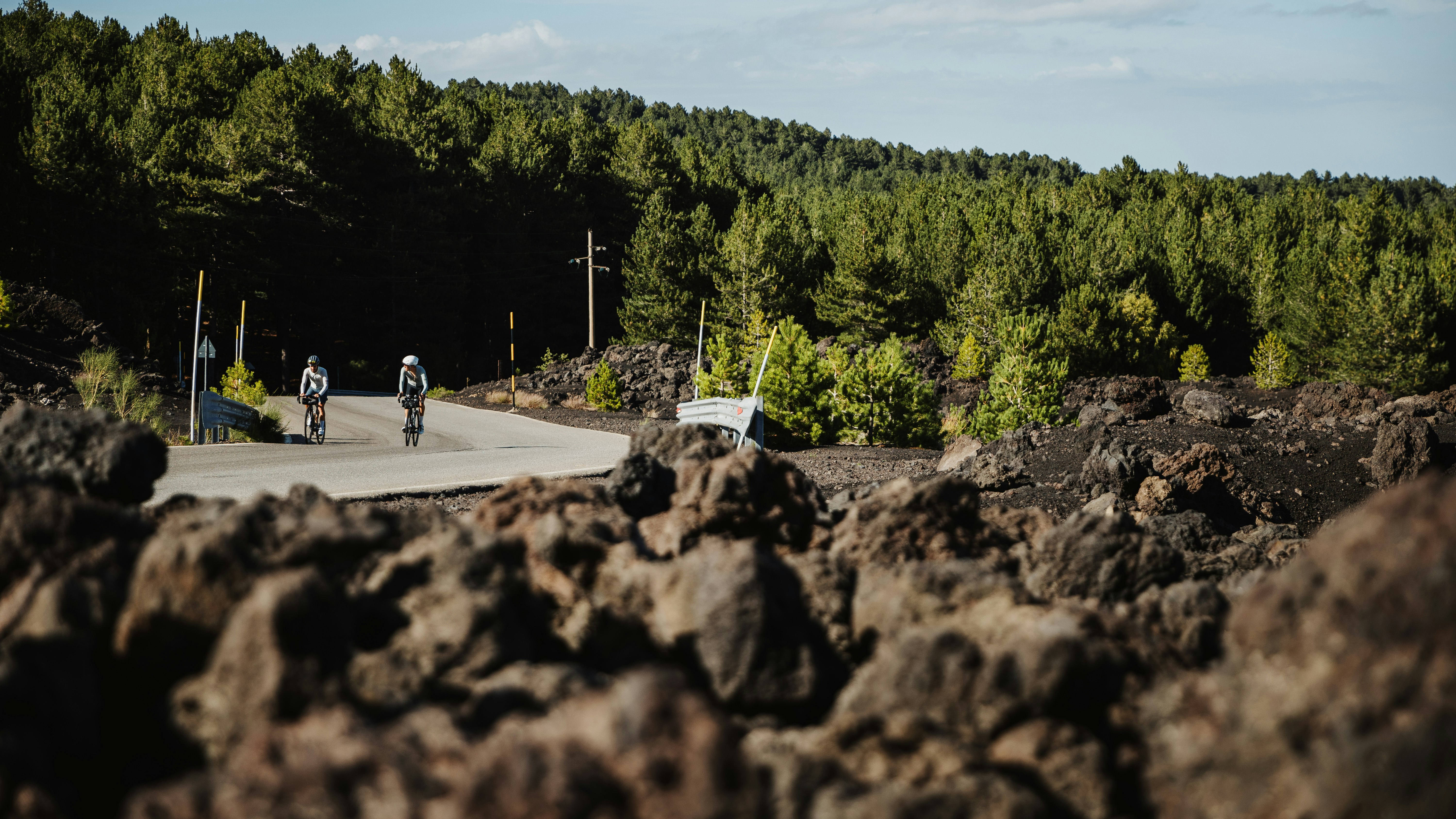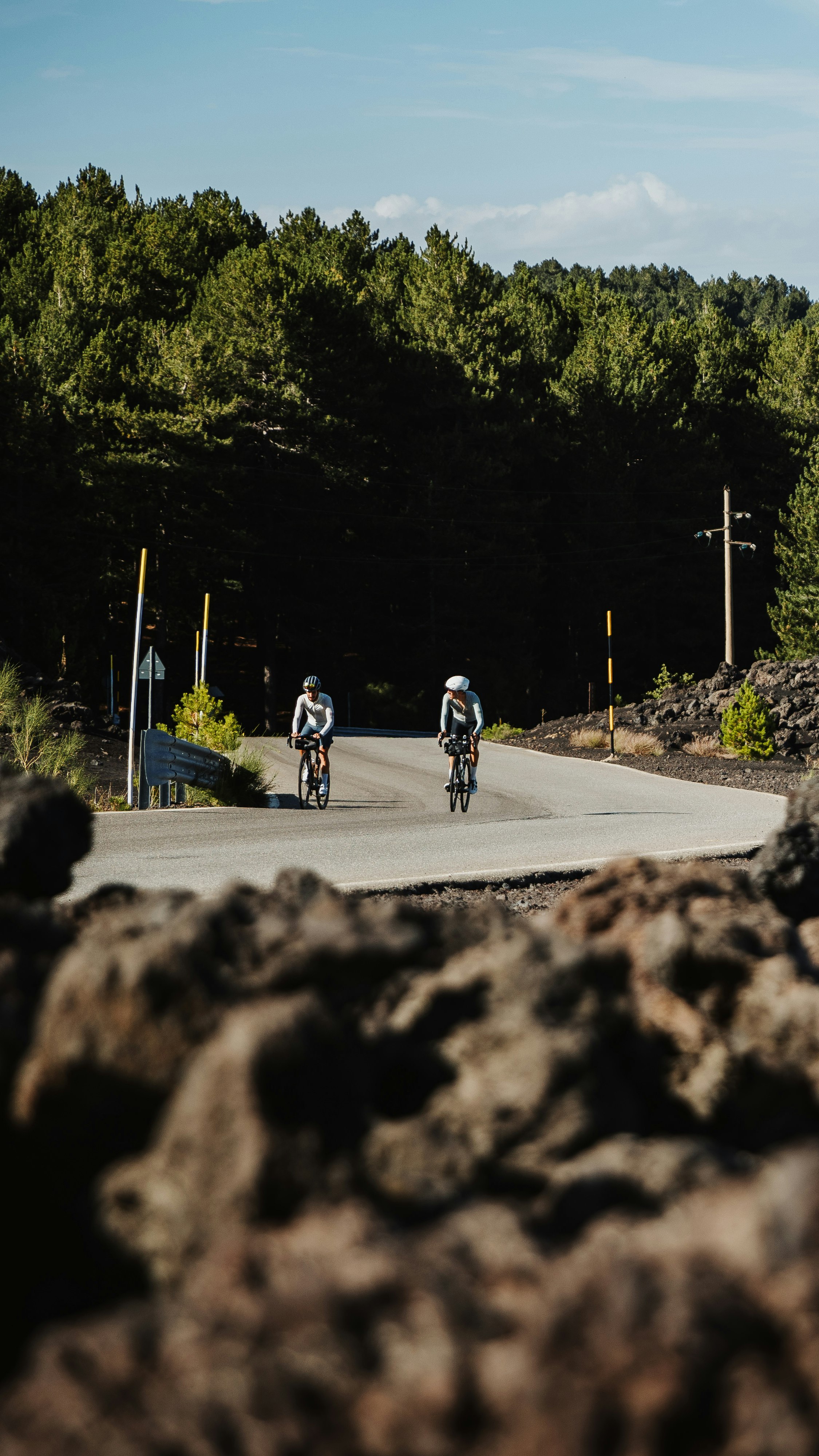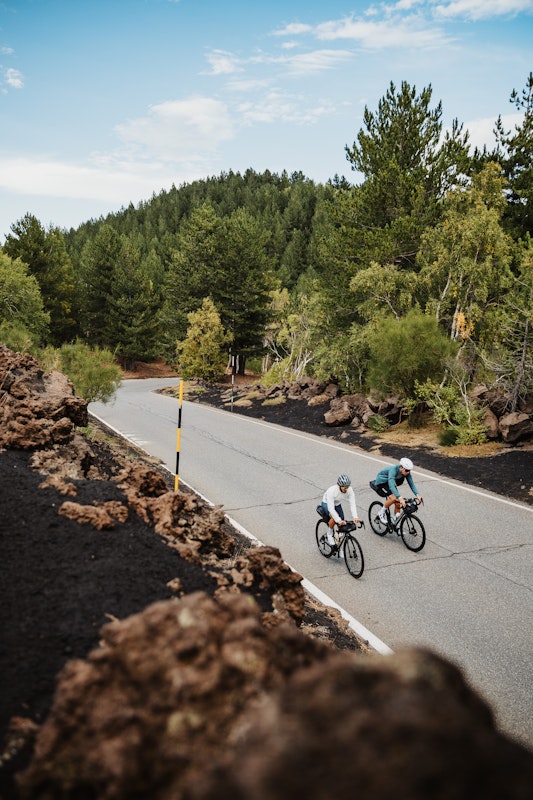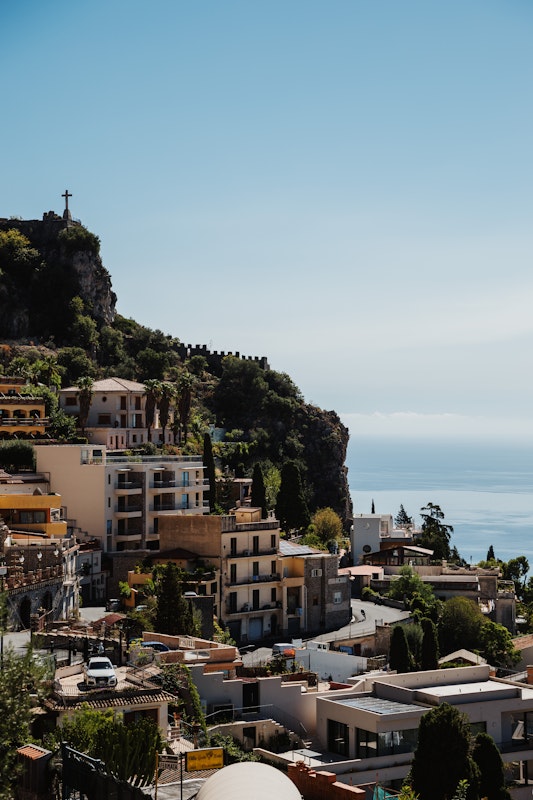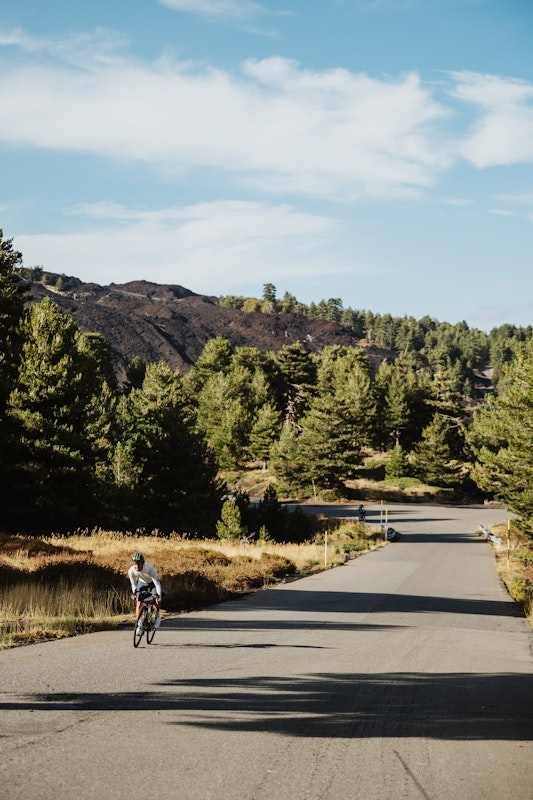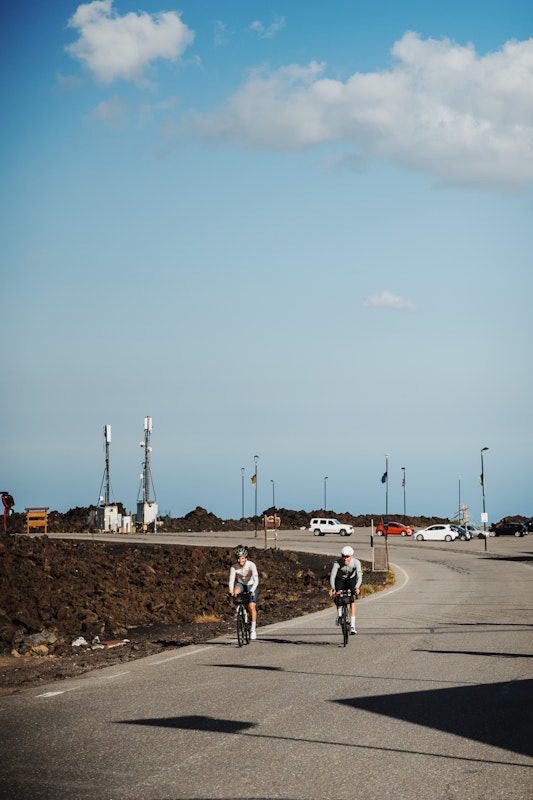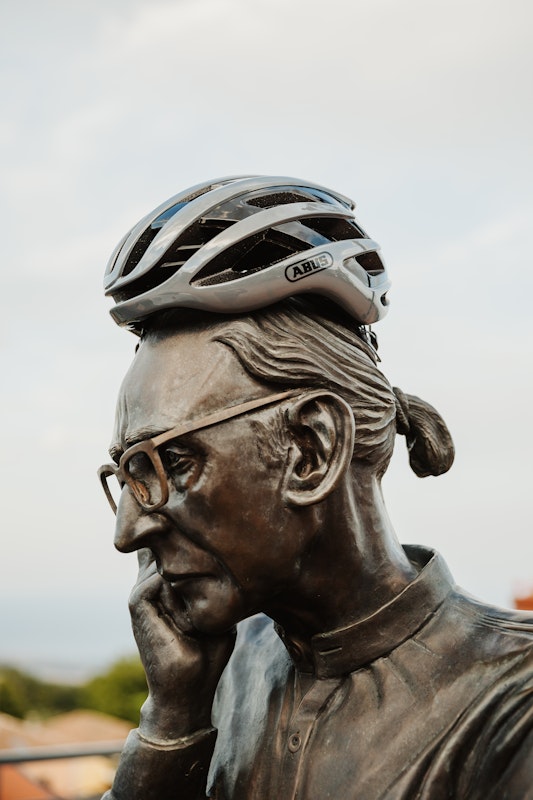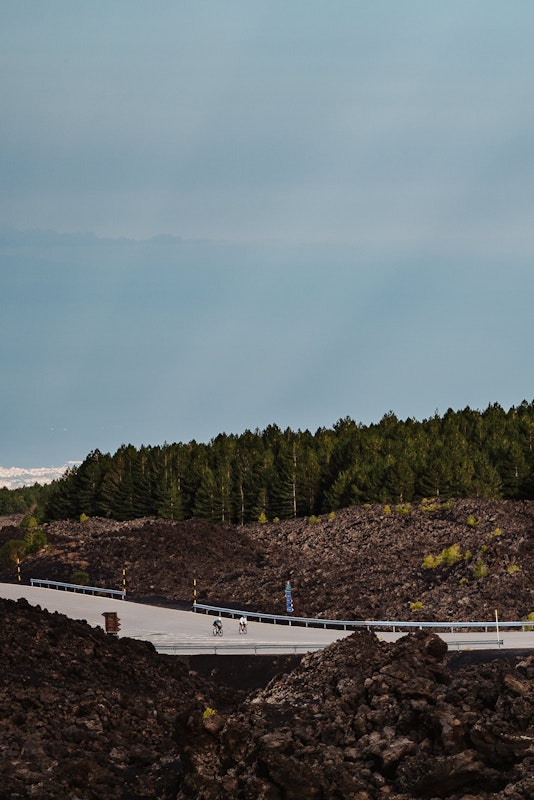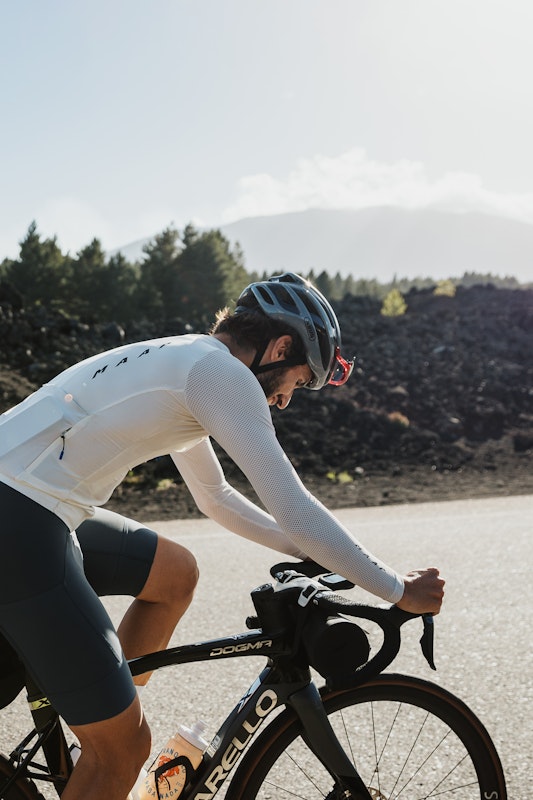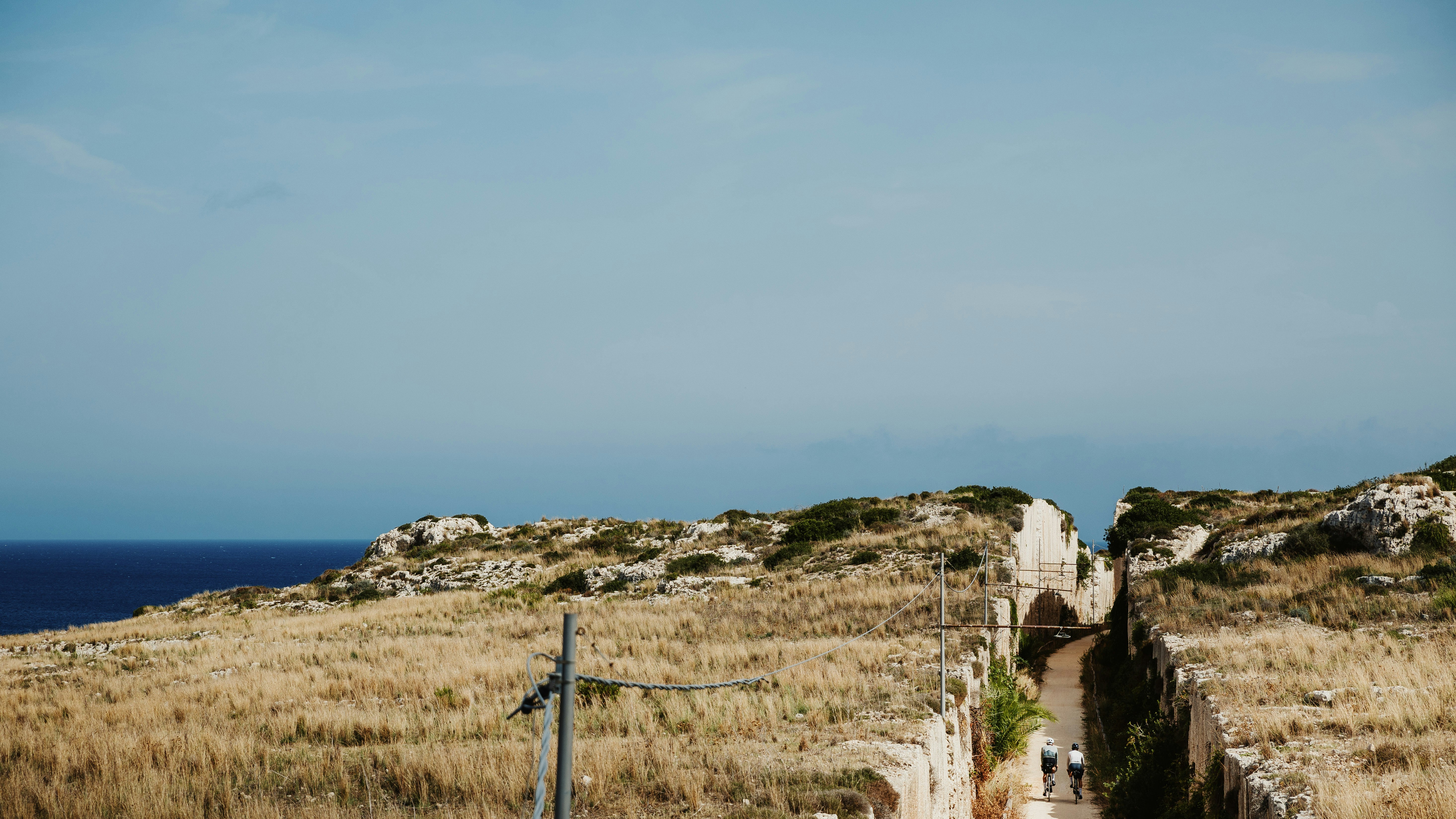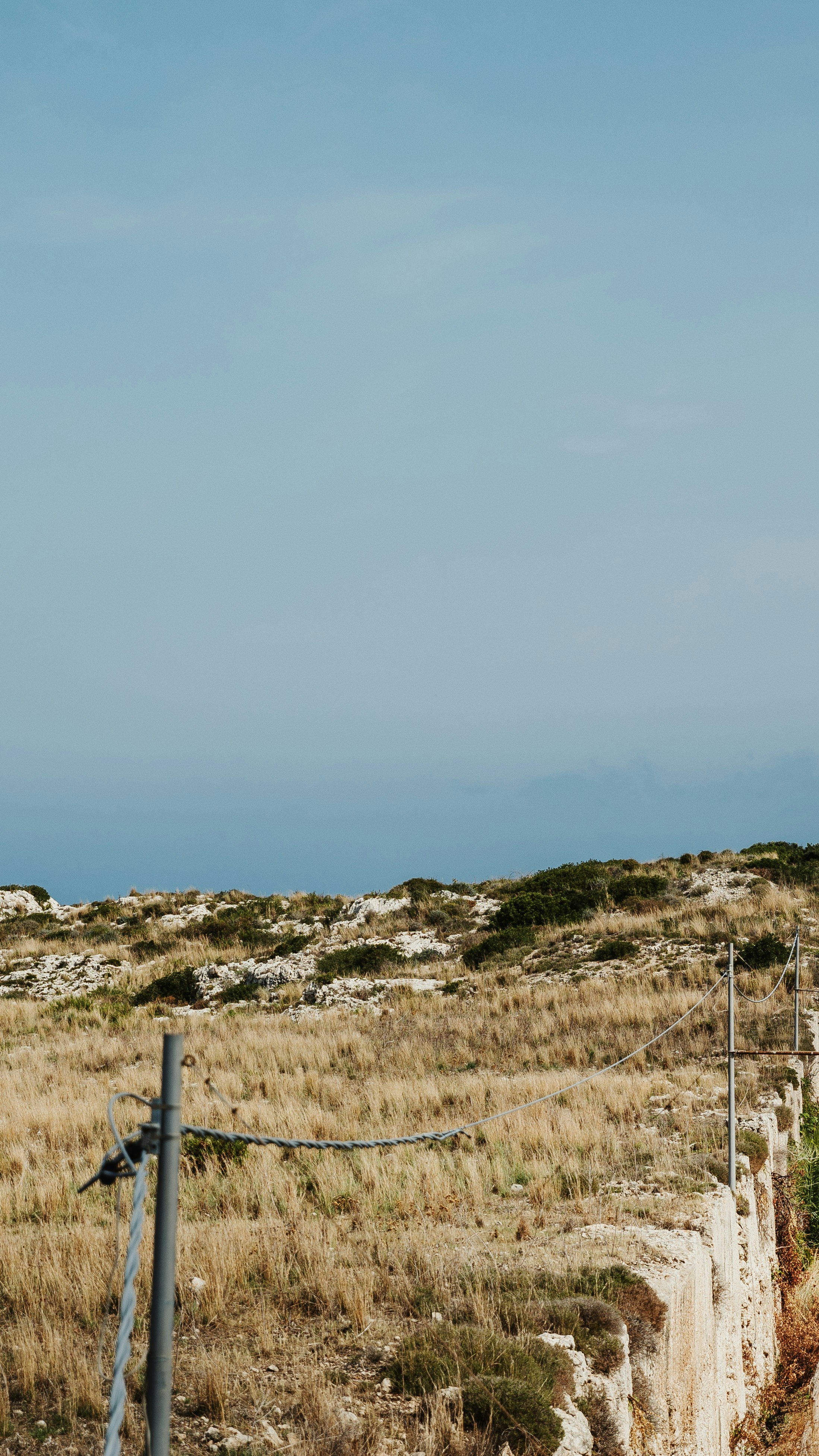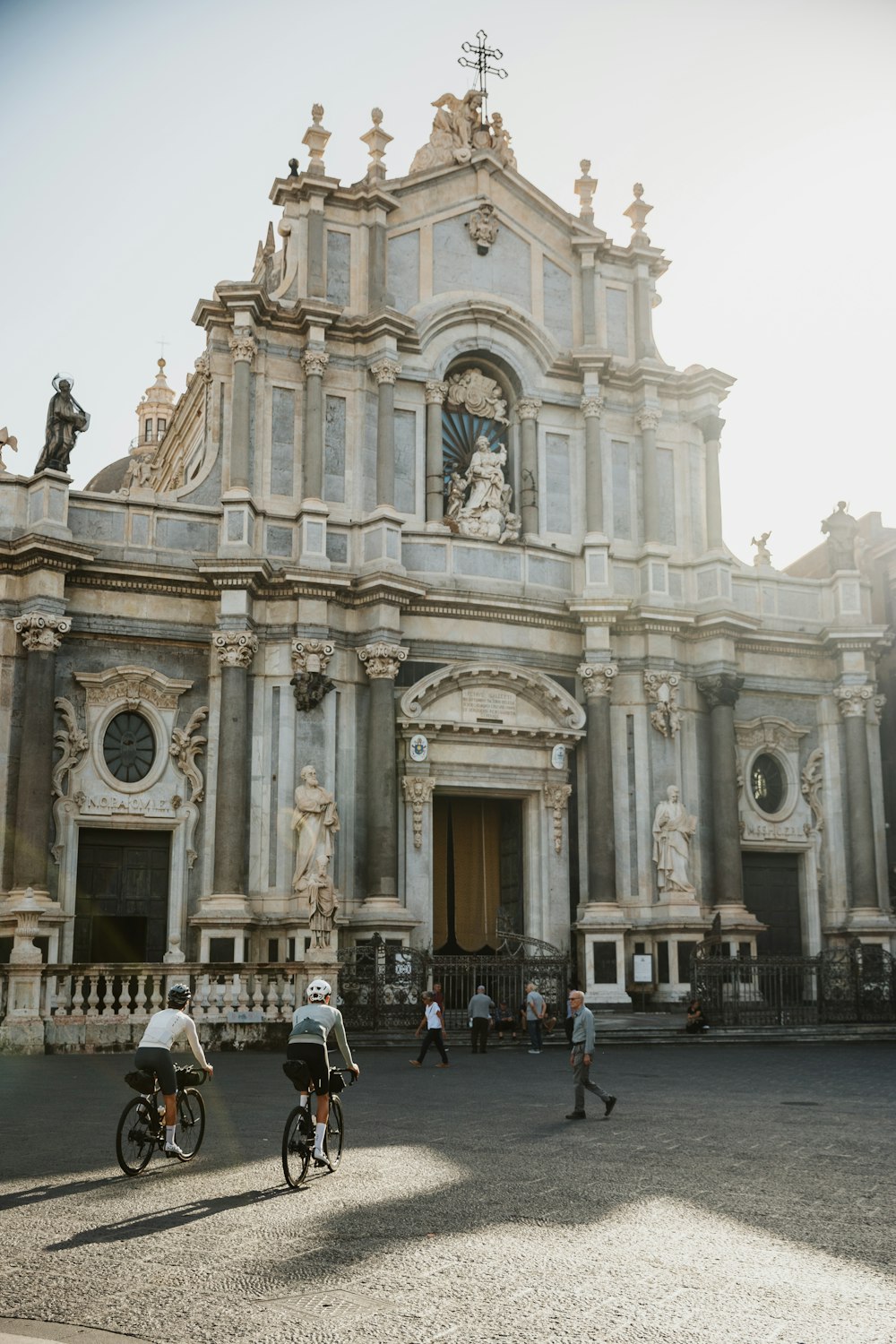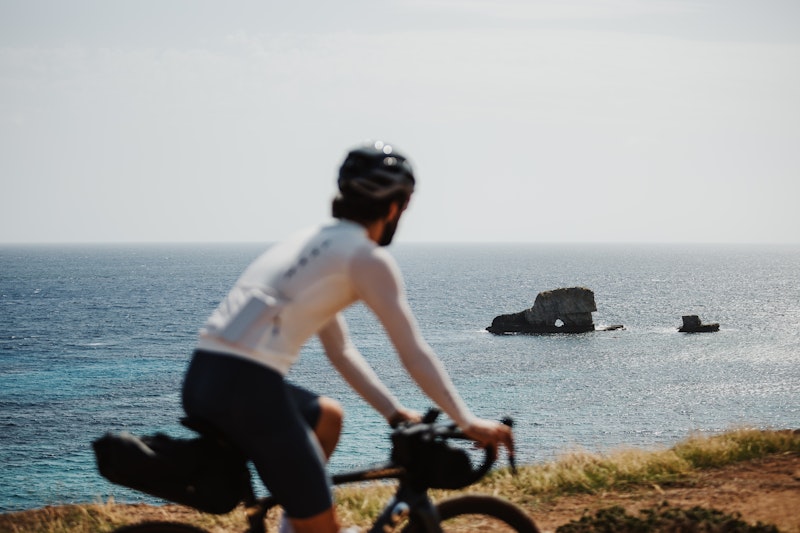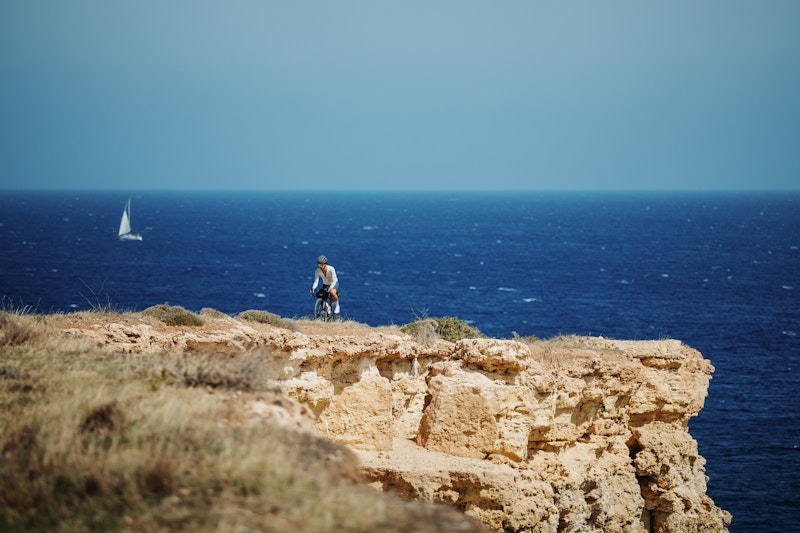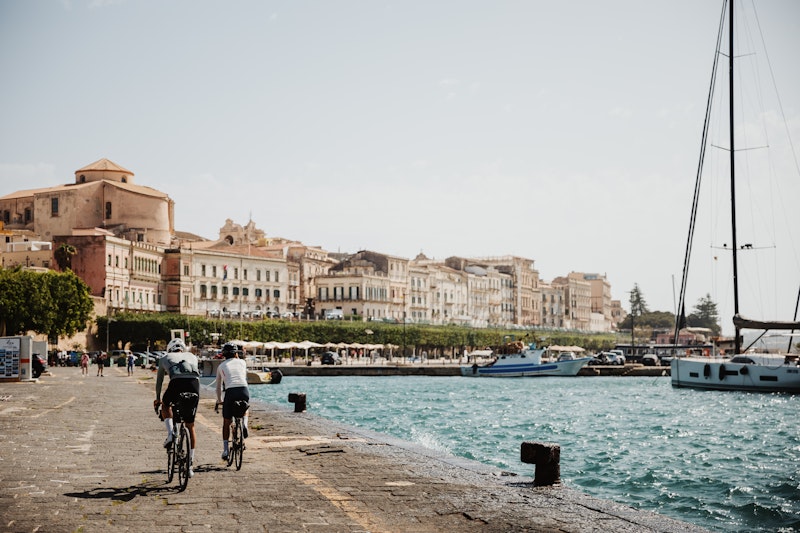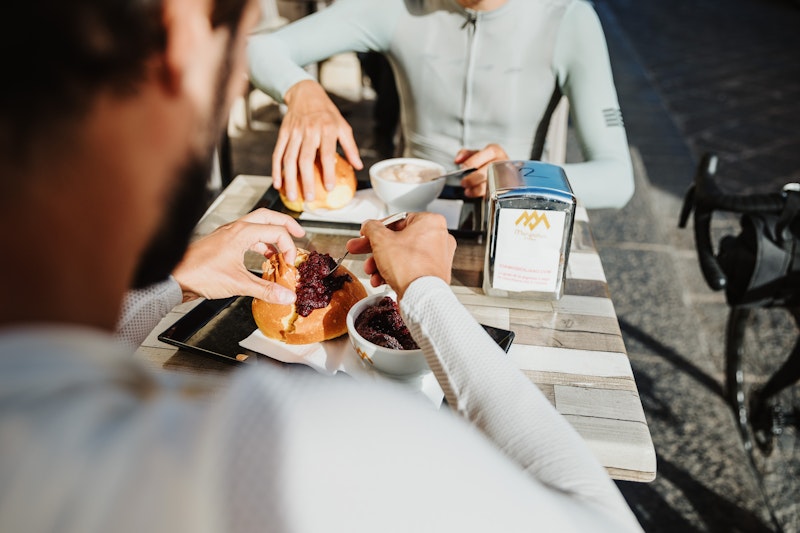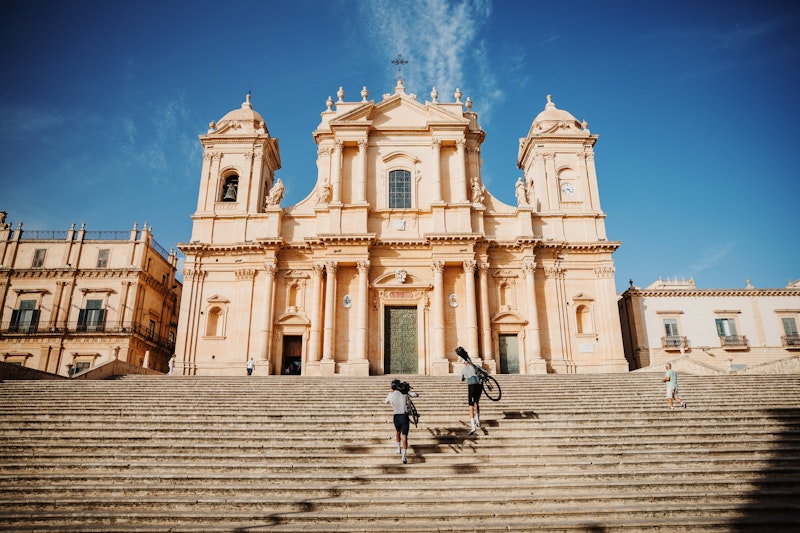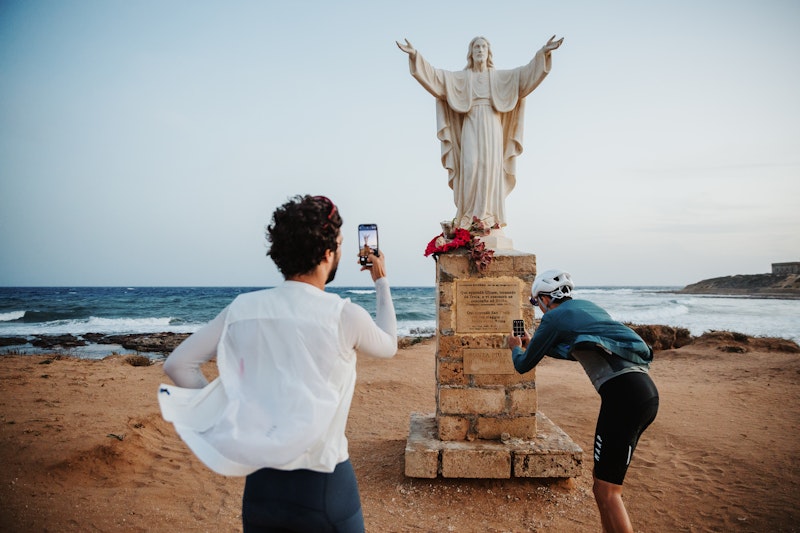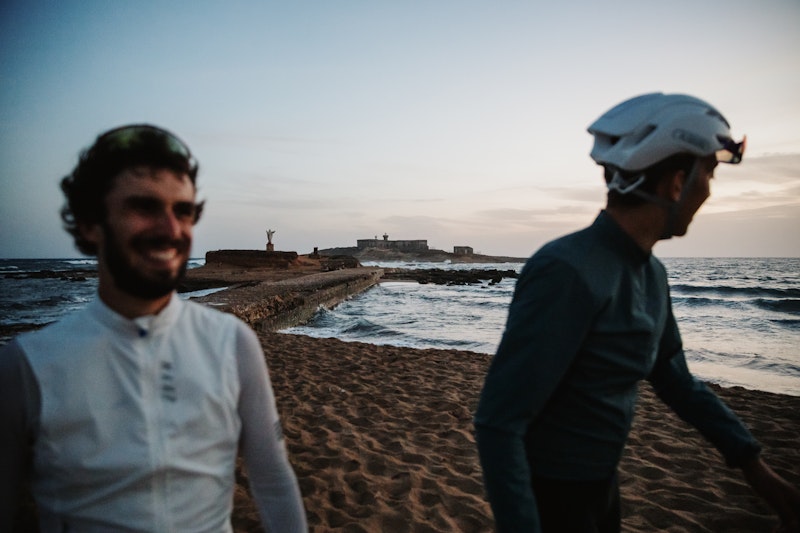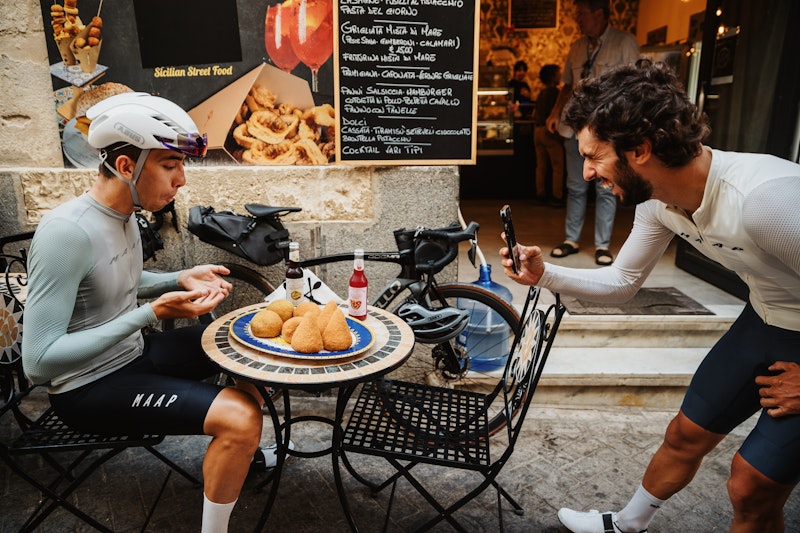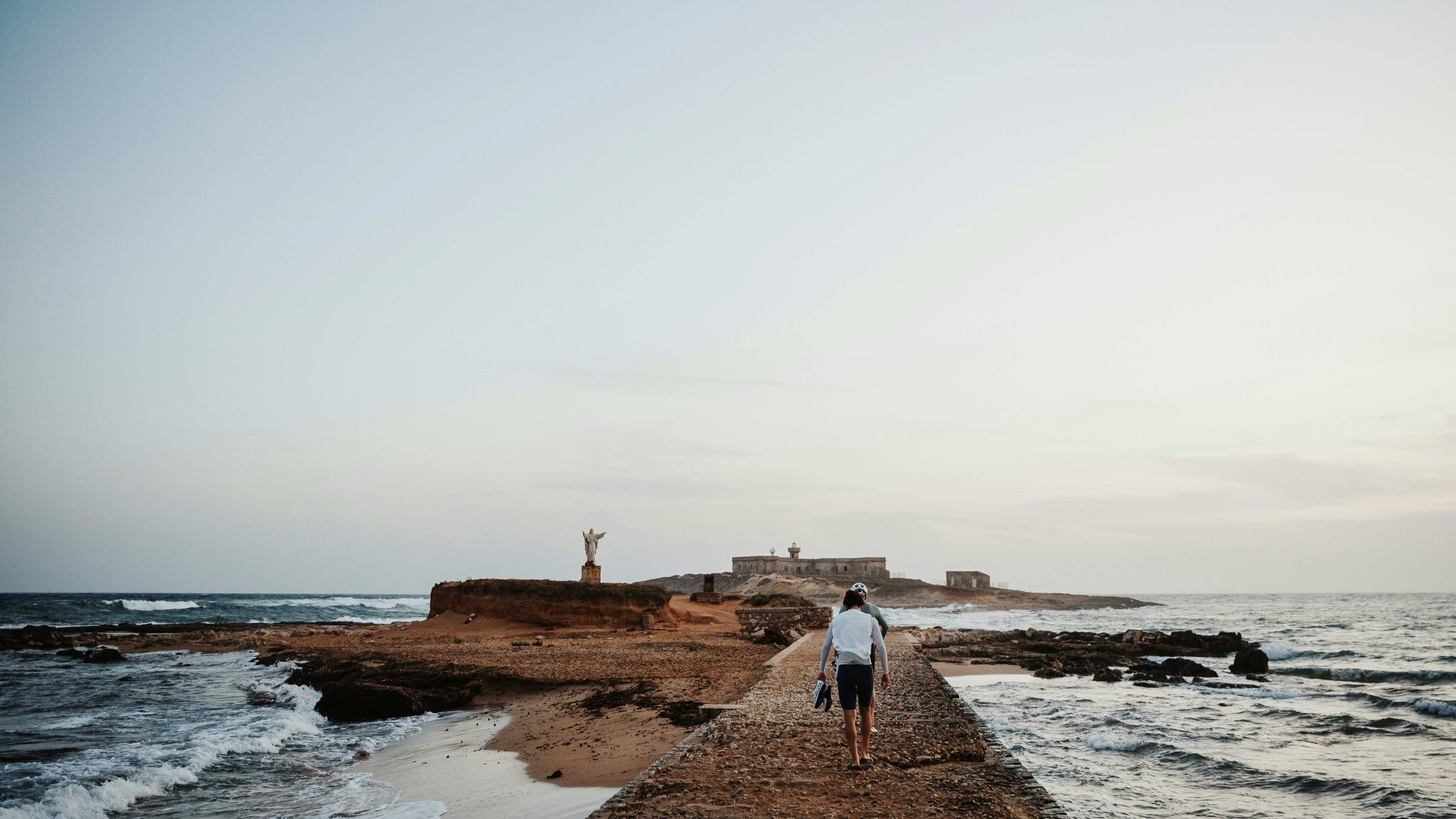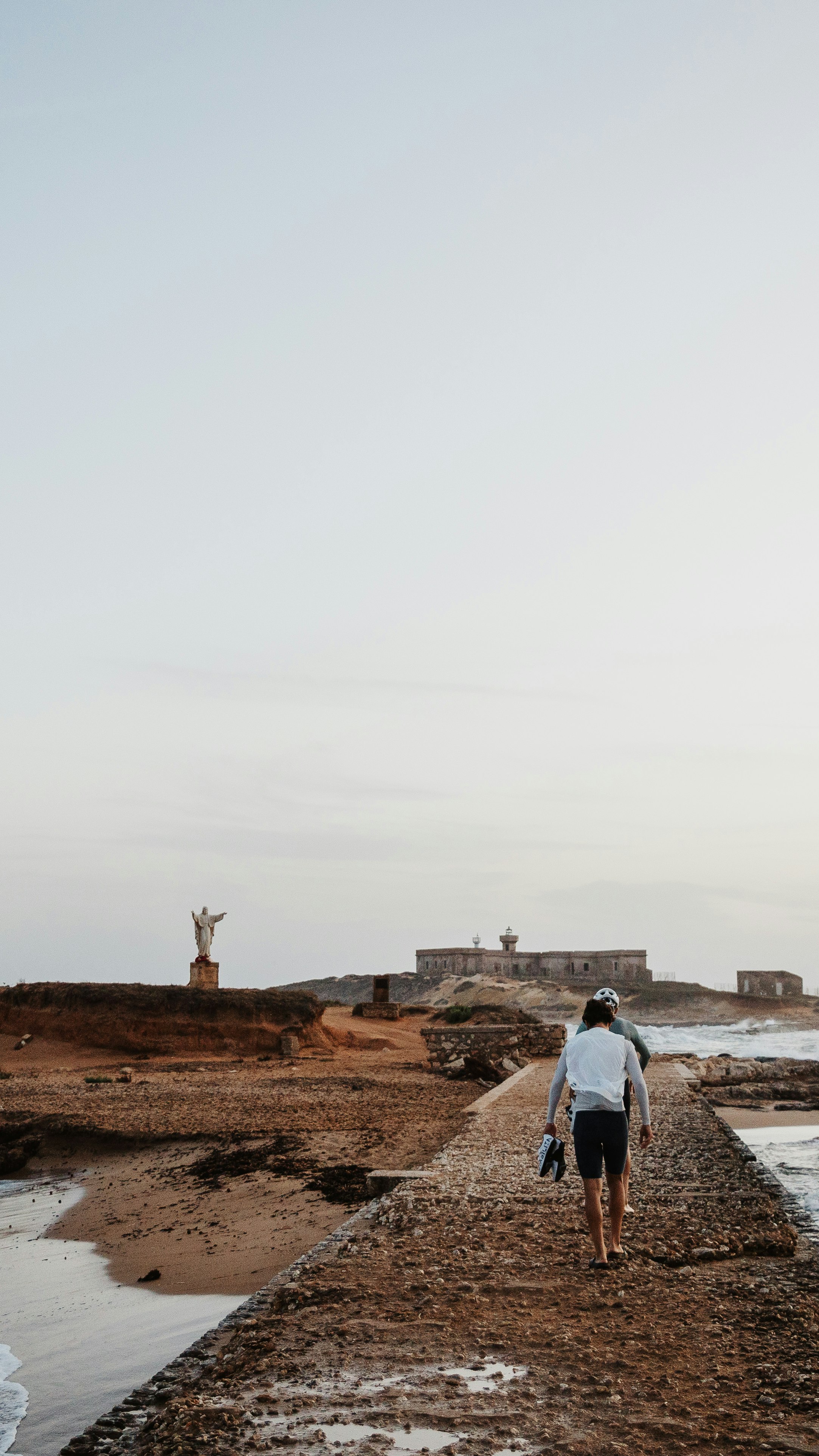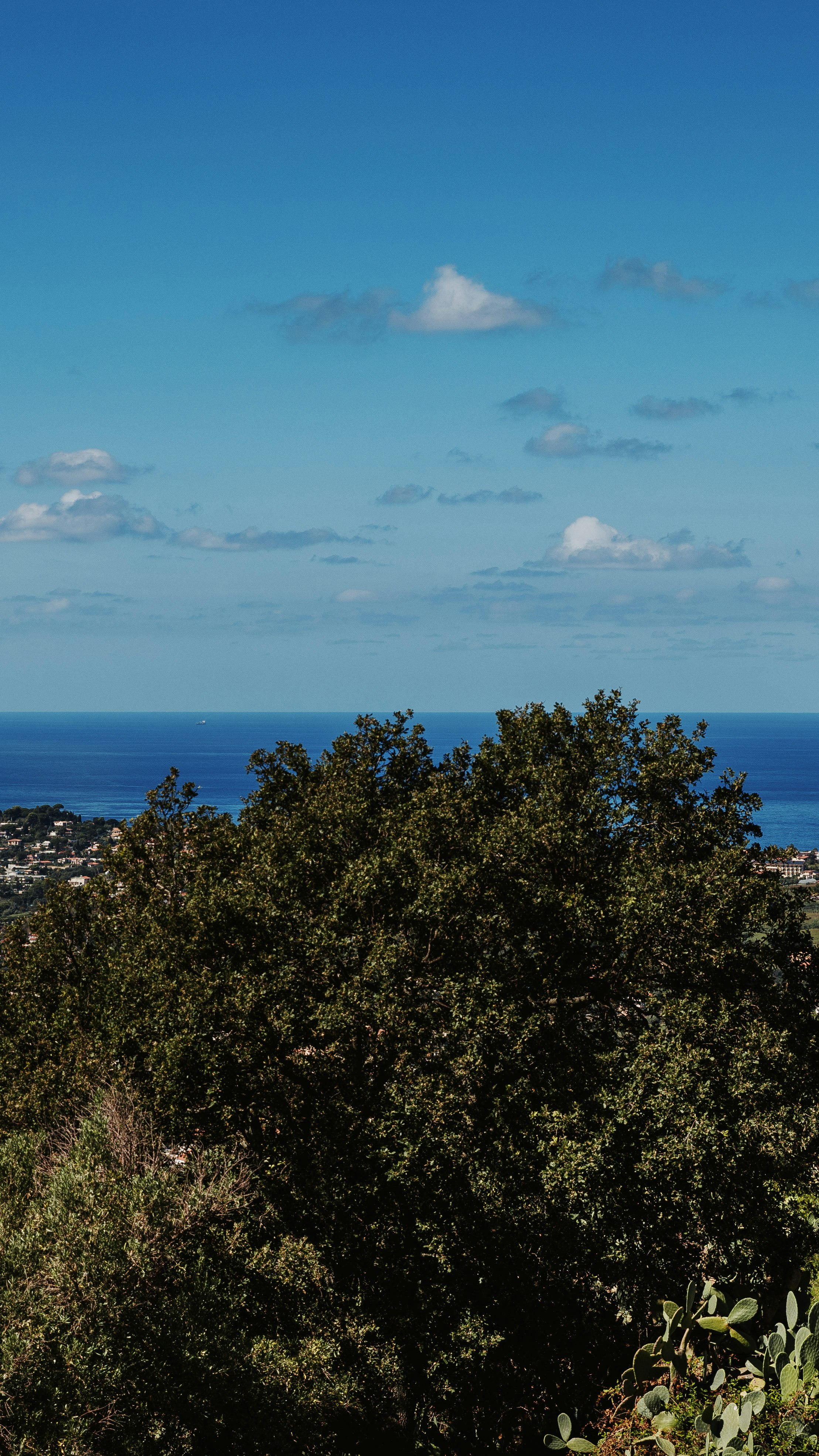
Big island, small islands
The mission is clear: to reach the southernmost point of the Italian boot. To keep going till it’s impossible to go any further… till you’re forced to stop. Because this is also travelling.
Period
Jan - Dec
Elevation difference
5604 m
Total Length
482 km
Duration
3/6 Days
I
The previous night, she asked for advice from some fishermen who were preparing bait just as she and her friends were leaving the beach. How strange, she’d thought for a second, are nigh-fishermen a thing? With their headlamps well-lit and their rods fixed to the ground, they confirmed that the tide is lower in the morning and the island is easier to reach. It’s from there that Irma wants to see the sunrise.
What fascinates her about this place is its contradictory nature: it is not a real island (it’s connected to the mainland by a stone path wrecked by the action of the sea), it’s considered the most southerly point of Italy (but Lampedusa is even further down) and sometimes of Europe (but some Greek islands are much further down). It is one of the most beautiful places in Italy, but hardly anyone knows by heart the town where it is located: Portopalo di Capo Passero. Here two seas meet, the Ionian and Mediterranean, so it says, but what is the former if not a part of the latter? And again: there is another Porto Palo (two words) in Sicily; Capo Passero is another small island a short distance away.
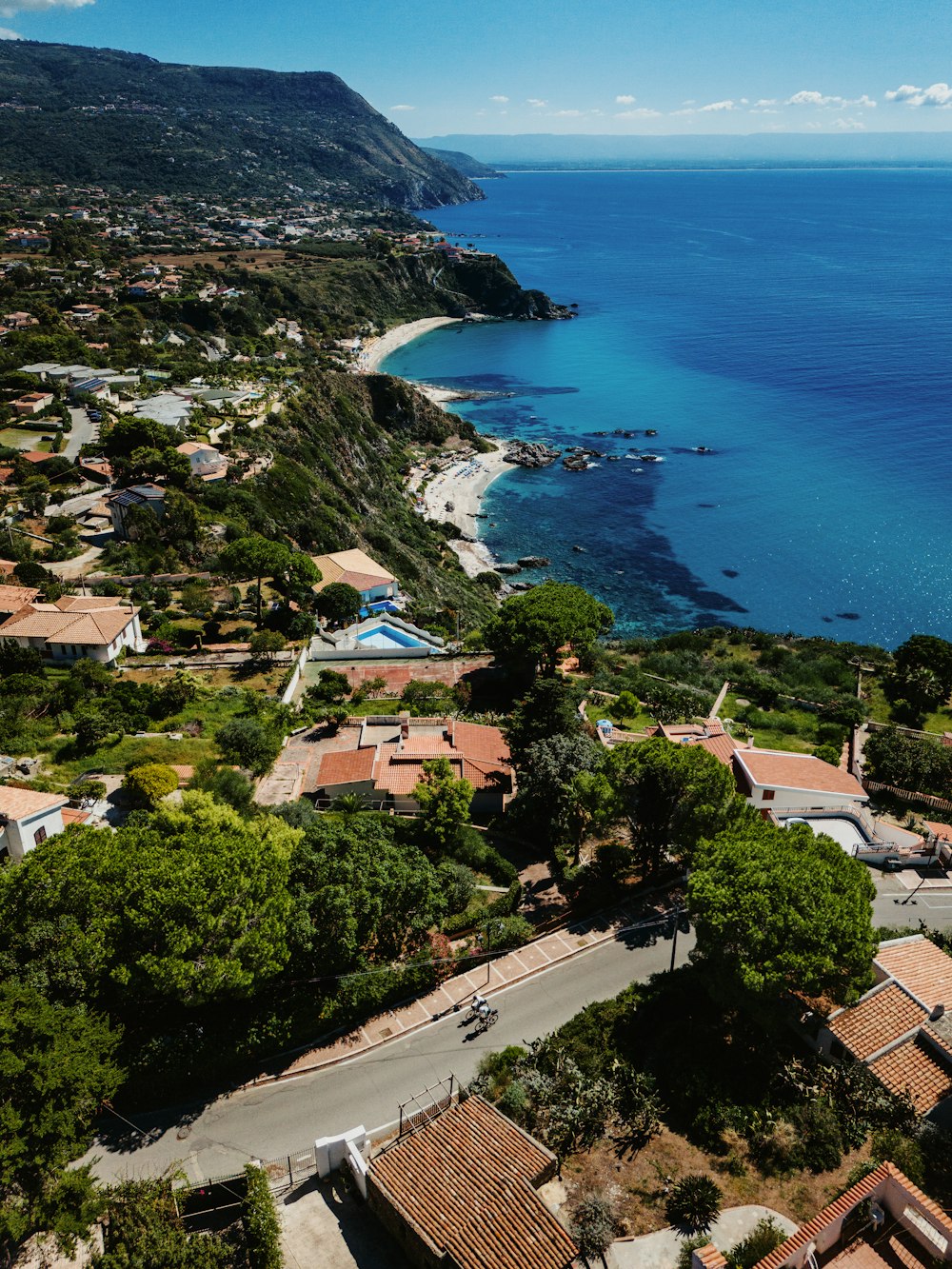
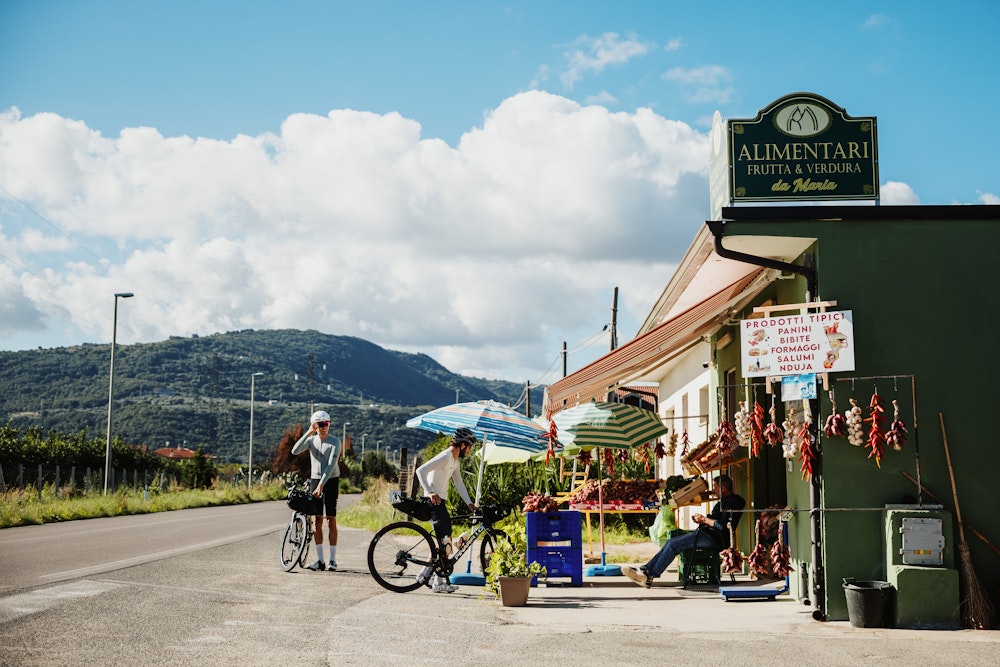
Once she has walked along the semi-immersed cobblestones, she finally reaches the island when the sun has yet to rise. She is about to sit down on one of the few grassy patches on the tiny islet, when her attention is drawn to a clinking sound. Between the rocks, battered by the waves, a glass bottle seems to contain something. It’s a rolled-up sheet of A4 paper, written on both sides, which so begins: ‘What do they want to communicate to us, the islands, with the presumption of thinking themselves the centre of the world, of believing that everything revolves around them, when it’s really just the currents and the fish? The most difficult thing about an island is simply to read it, to understand what language it speaks and what inexhaustible tale the sea murmurs.’ The quote comes from Ernesto Franco's Storie Fantastiche di Isole Vere [Fantastic stories of real islands]: Irma cannot help but continue reading. It is a travelogue and an island journal, written every day by a different pen. Probably as the day finishes.
Easy landing in Lamezia Terme. It’s the first days of October, and while in the north the temperature is starting to get dangerously close to 10°, in Calabria there’s 30° at midday. That's what I call putting winter off. With two friends, Donato and Nicola, we have a goal in mind: to reach the southernmost point in Italy, Isala delle Correnti, in three days. What kind of place is an island as a destination for a cycling trip? Not only are we travelling to an island, Sicily, but our final destination is a laughable islet, on which nothing happens and that often cannot even be reached. How many things outside of us and our bicycles will we have to rely on... who knows if we will ever get there.
I don't remember much of the Costa degli Dei - that's what the Tyrrhenian coast is called here, because of who knows what Greek legends – all the way to Tropea. My fellow travellersreally knuckle down on the plain, and to tell the truth there wasn't much to see other than onion fields. Pizzo Calabro, yes Pizzo Calabro is beautiful, even though we didn't drive there in a Subaru Baracca. At Tropea, however, we find ourselves in strangely named street, Raf Vallone. Intrigued, I do a quick search and come across the only person, at least I think, who has won both a Coppa Italia (with Torino in the 1930s) and a David di Donatello (in 1962 for the film Uno sguardo dal ponte [A View from the Bridge).
The Calabrian coast overlooking the Tyrrhenian Sea has two islands: Cirella, in the municipality of Diamante, and Dino (Praia a Mare). Both are almost 200 kilometres further north. Then, further down along the coast, nothing more. Tropea did have an island: the promontory on which the Santa Maria sanctuary stands was in fact separated from the mainland in the past. Today, a beach connects the sandstone cliff to the town of Raf Vallone, the penultimate in size of Calabria's 404 municipalities.
Sicily also had an island. It emerged out of the Strait of Sicily, between Sciacca and Pantelleria, in June 1831 only to disappear in January 1832. Both events were caused by the same occurrence: the eruption of an underwater volcano. Each national fleet that thought they were first to discover it gave it a different name. In Sicily at least, prevailed the name Ferdinandea because of the presence on the island, in those very weeks, of Ferdinand II, King of the Two Sicilies. Flaubert, Verne, Pirandello, Camilleri have written about her: the literary appeal of something as ephemeral and grandiose as a disappearing island is irresistible.
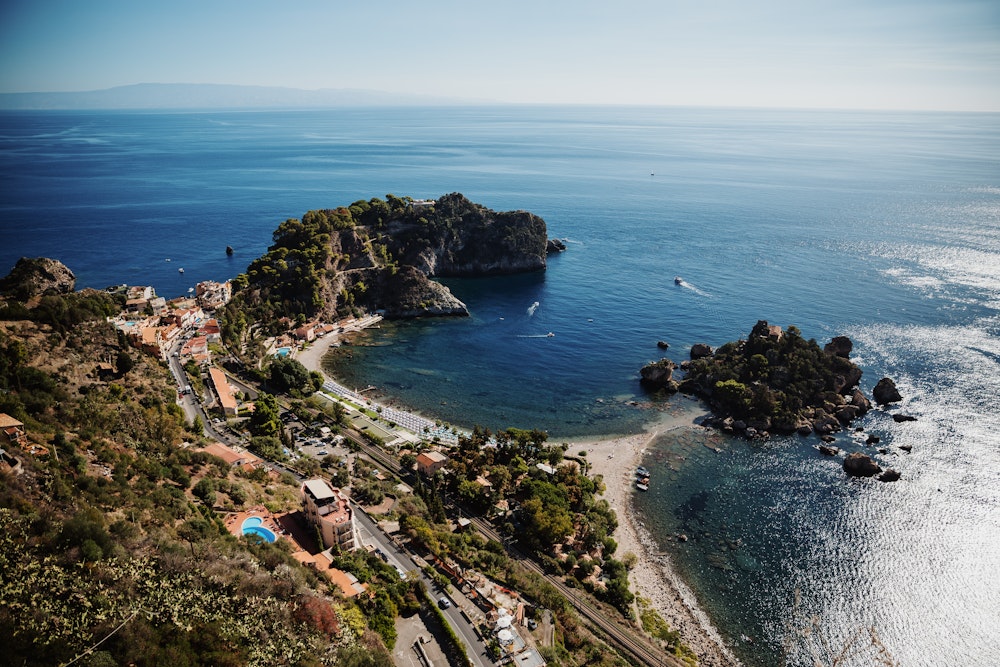
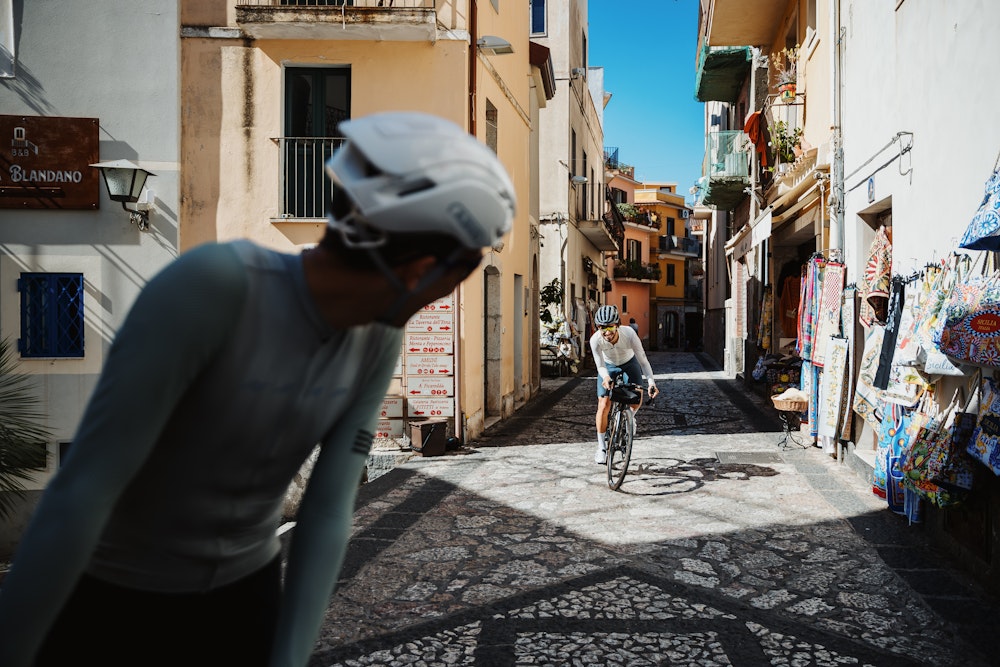
From the Calabrian coast, between Briatico and Capo Vaticano more or less, incredible for those of us who have never been there, another Sicilian island, also a volcano, comes into view: Stromboli. In the last restaurateur still open at this point in the summer season, Roberto, in Marina di Nicotera, tells us about it: ‘In front of us – we are on a veranda overlooking a deserted beach – is Panarea, which you can just about make out. And then Vulcano, look at it there. I must tell you the truth: I'm very ashamed but I've never been there, to the Aeolian Islands. But where I would really like to go is Stromboli'.
As the sun sets, we reach Bagnara Calabra via the scenic hairpin turns on the south side of Monte Sant'Elia. The sun, going down behind the hills of Messina, sets the stone churches on fire, the viaducts under which we speed up, the remarkable Villa De Leo in art nouveau style. Bagnara (and a nearby village with the seemingly fictitious name of Melicuccà) is the home of the wealthy Florio family, whose fame is linked to that of another Sicilian island, Favignana.
The island was bought by Ignazio Florio sr. in 1874 for just under three million lire and a revolutionary tuna fishery was built there. For the first time, in fact, instead of being preserved in salt, tuna was put in oil and canned. But we don’t have enough time to think aboutthe novel The Lions of Sicily, the sunset is underway and Villa San Giovanni is still a long way off.
Thanks to a time trial worthy of Team Columbia-HTC with Marco Pinotti, Michael Rogers and Tony Martin, (give or take), we pass Scilla and its fishing village Chianalea. It is no coincidence that in his mammoth work Geografia, the philosopher Strabo wrote that Scilla stands on a rock that gives it all the appearance of an island. And as we pick up the pace towards the Strait of Messina and the ferry, I think Scylla sometimes must indeed set sail. It does this with all its inhabitants, whether they know it or not, and it is not certain that anyone on board realises this. From the bow of the ferry, we take a good look at it: there it is in front of us, the big island.
Sicily is the largest Italian region and the largest island in the Mediterranean. I am not just talking about square kilometres: no other place manages to bring together a history of thousands of years, breathtaking sea and mountain landscapes, astonishing cuisine, incredible writers, contradictions, a melting pot of peoples and cultures, and everything else. In addition to the main island, various archipelagos (Aeolian, Egadi, Pelagie) make up about 1% of the regional surface area and 18 of the smaller islands are inhabited. Two cities, Syracuse and Augusta, cared so much about their islands that they annexed them with bridges and gangways. Now you struggle to notice how far on the island you are, and whether you’re actually there or not.
The first two hours from Messina to the south this morning went as smoothly as the sea in the Stagnone [Large pond] of Marsala. The road only starts to climb near Isola Bella, which is connected to Taormina by a thin strip of sand. We do not necessarily have to climb to Taormina, whose centre is as beautiful as it is choked with tourists, but we do want to enjoy the views of Castelmola, the hometown of almond wine. It was invented at the Antico Caffè San Giorgio, in the main square of Castelmola, with black and white tiles, from which you can see both the crystal clear sea and Mount Etna.
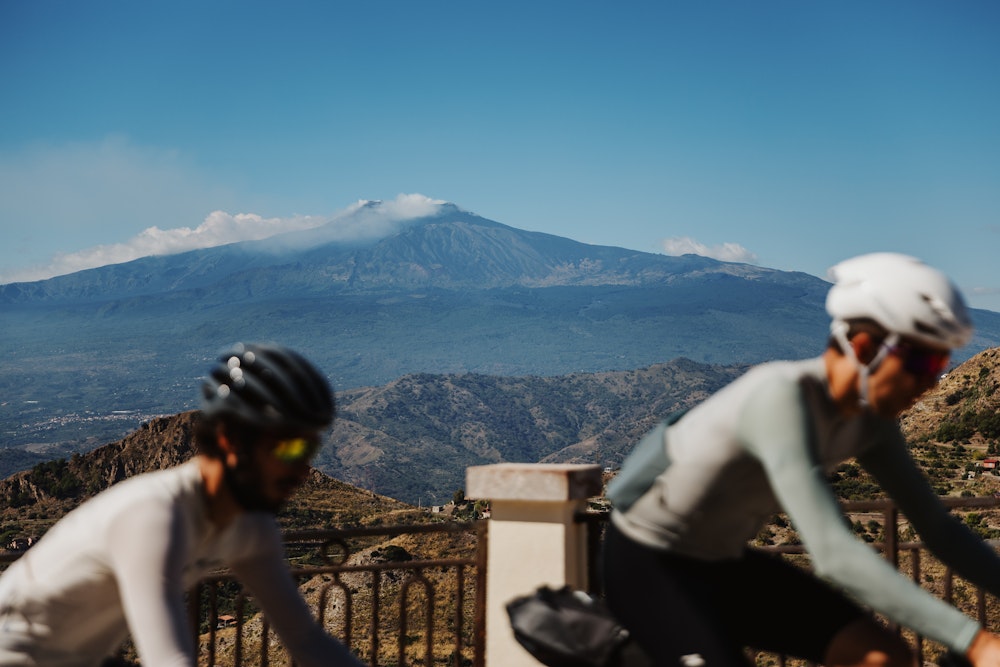
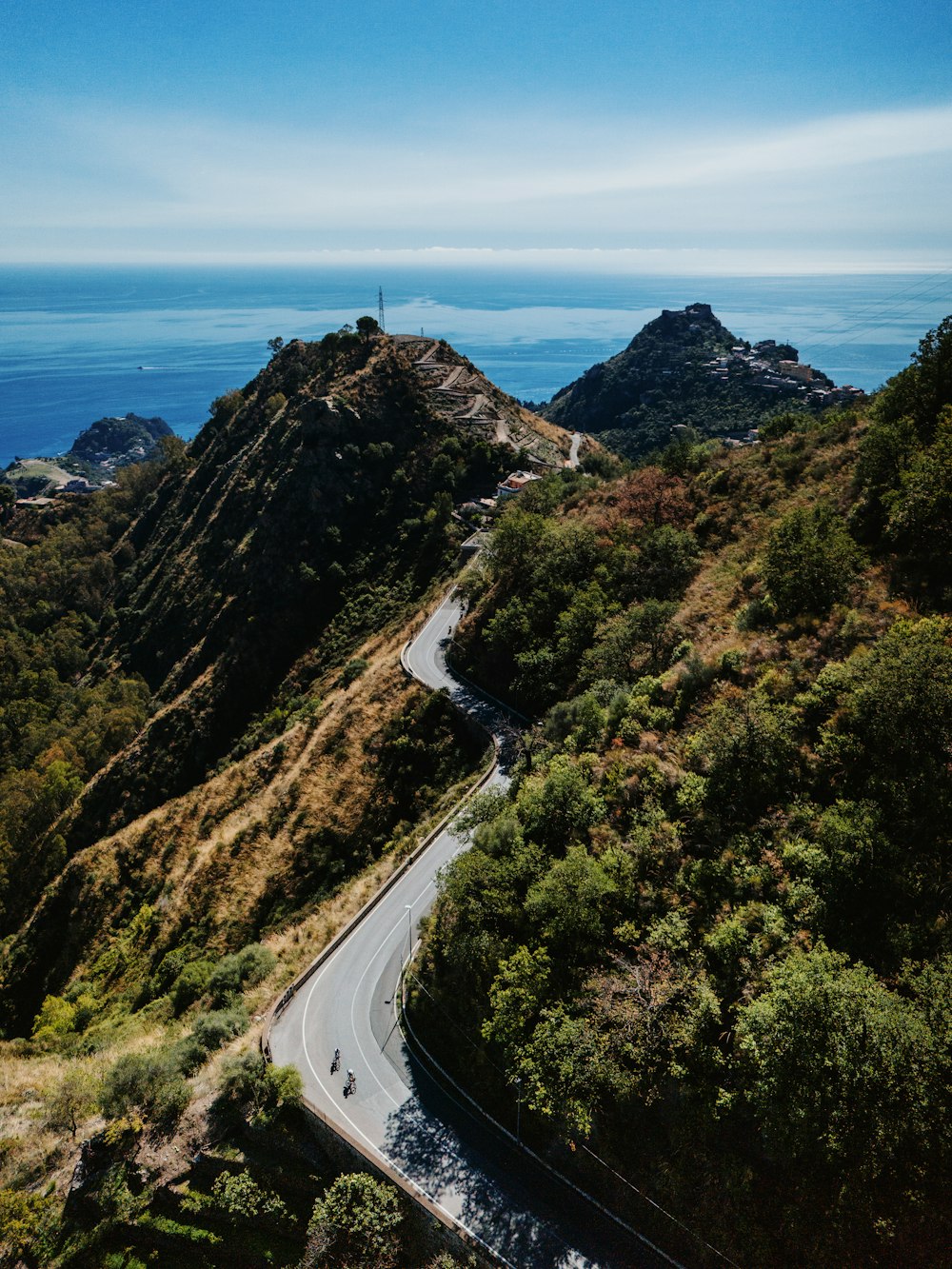
It was a historic stage in its own way, also because it was contested to the very end by a man from Palermo, Giovanni Visconti. Piano Provenzana is the north-eastern slope, from Linguaglossa to the summit it is 18.6 kilometres at an average of 6.7%, but you really start climbing after Fiumefreddo. After a detour into the valley of the Alcantara river, we shift to the easier gears and ride into the woods.
Larch, fir and pine trees envelop the road called, very poetically, Mareneve [Seasnow]. Between the Brunek and Ragabo mountain refuge, just before the hard bit, a gentleman stops a policeman and asks him: ‘hey chief, to go where I have to go, should I head for Milo? God knows where he had to go, but the man headed for Milo. Three kilometres from the end of the asphalt road, and suddenly, the forest opens up onto a vast lava flow. The black rocks, basalts and the ash we see come from the 2002 eruption, the perfect eruption, one of the most significant in recent decades. It completely destroyed Piano Provenzana. Mr Nino, 73, lost four buildings in those days: ‘It took everything away from us. Unfortunately, lava has no eyes'. However, he hasn’t stopped coming to Piano Provenzana, quite the contrary. His favourite thing about Mount Etna are the porcini mushrooms that grow in the woods: under the black earth, white mushrooms grow.
Unlike the slopes of Nicolosi or Ragalna, the lava flow here is recent, and has kept its colour. Black, pure. It seems to have solidified only yesterday. As we descend towards Milo, the village where Lucio Dalla and Franco Battiato used to meet, the forest of evergreen trees gives way to deciduous trees in autumnal colours. The reddish yellow of the leaves mixed with ash black and sea blue creates a unique landscape. We would like to sit and wait for someone to talk, someone like the protagonist of Dalla's song the ‘Siciliano’, but the Riviera dei Ciclopi awaits us.
It is curious that these small islands, little more than rocks in front of Aci Trezza, share their origin with an active volcano higher than the Marmolada. Without delving into a treatise on plate tectonics, let’s just say that about half a million years ago the collision between the Euro-Asian and African plates generated both Etna and the stacks of Aci Trezza. These are the last islands we will see for several kilometres. The Casa del Nespolo museum and the Aci Trezza fishermen's club have already closed. It’s almost evening, better to continue towards Catania. We have a map with a route designed to never to return.
There are atolls of the soul inside the city of Catania. Breakfast at Prestipino's, between the cathedral of Sant'Agata and the fish market, within sight of ‘u Liotru, is one of the few luxuries we allowed ourselves. The Benedictine monastery, opened to the public again thanks to the Officine Culturali association, is so majestic that it inspired Federico De Roberto's book I Viceré [The Viceroys]. Not far away, the Legatoria Prampolini is the oldest bookshop in Sicily. ‘This year we are celebrating 130 years of history. Verga, De Roberto and many others used to meet here for their literary Thursdays. It’s a very important place for Catania’, Angelica the bookseller tells us. On display are books by Goliarda Sapienza, an author born in Catania a hundred years ago, whose fame comes mainly from her posthumous book L'arte della gioia [The Art of Joy]. Angelica warns us: ‘You should prepare yourself because it's a book that will take you by storm’.
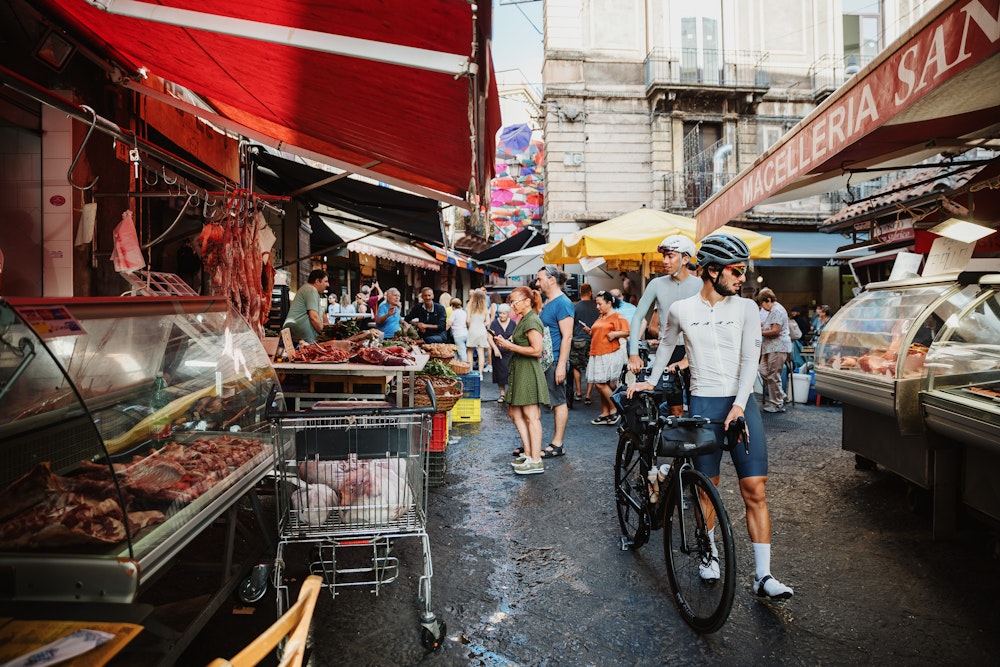
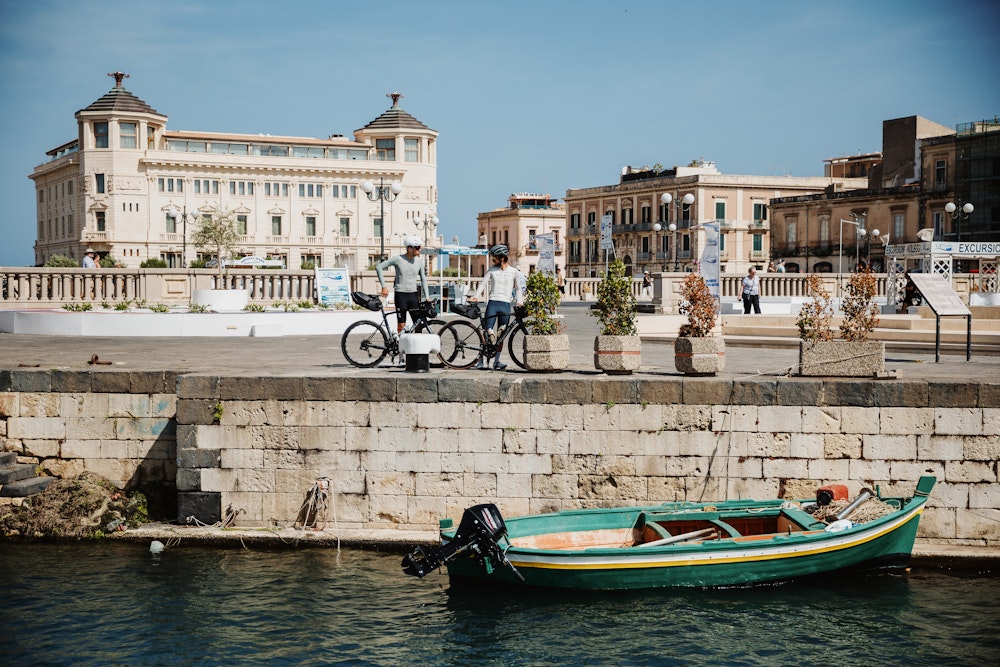
By the time I stop thinking about Angelica’s warning, we are already on the Rossana Maiorca cycle path towards Syracuse. Named after the freediving champion, it overlooks the coast and Ortigia gets closer and closer. High cliffs and white stone quarries line both sides of the cycle path. If Ortigia is perfect for photos, for the Sound Festival and, alas, for hit-and-run tourism, Ognina – a few kilometres further south – is ideal for those who enjoy Sicily far from the spotlight.
The singer Lorenzo Urciullo, aka Colapesce (the name derives from a well-known Sicilian legend), who spent part of his childhood in Ognina, speaking of the soundtrack he has just composed for the film Iddu on Matteo Messina Denaro, says: ‘I am fed up with the Sicily of carts, arancini [rice balls] and granita [slushy]. Not so much with the one presented by Commissario Montalbano, where at least there was the narrative intelligence of Camilleri, but rather the picture perfect Sicily of White Lotus. There is also this hidden, underground, dark Sicily: in the film you can see it, and very well.
Opposite Ognina is a small island by the same name, flat and tiny, but we are barely in time to glimpse its outline and we are already heading straight for Noto. The tiny, elliptical shape, here, belongs to an island for cycling seems out of sorts in the capital of late Baroque now famous for Fedez and Chiara Ferragni's wedding. Yet, not far from the towers of the cathedral of San Nicolò, the velodrome dedicated to Paolo Pilone holds its own.It’s not really a modern facility, but it’s frequently used nonetheless. In 2024, it hosted the Italian Youth Championships and even when we get there, the place is buzzing with life: under the steep banks, some kids play football.
The stretch of coast that includes Vendicari’s nature reserve, Marzamemi and Pachino down to Portopalo di Capo Passero is one of the most beautiful in the whole of Sicily. There is a strong sirocco wind: it comes from the south-east and blows like a hot hairdryer in your face. The last pedal strokes take us all the way to the island of Correnti. Just before the crossing, the only bar on the beach attracts us like flies to honey. Abdi, the young Egyptian bartender, asks if we know the stories of Ulysses and St Paul, who landed here after many adventures during their travels. We do not know them. And he asks if we know what suruq means in Arabic, besides sirocco: we don't know that either. It also means, and this I don't think I will ever forget, dawn of the morning.
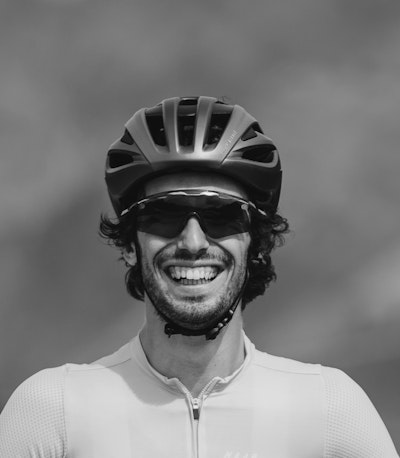
Texts
Michele Pelacci
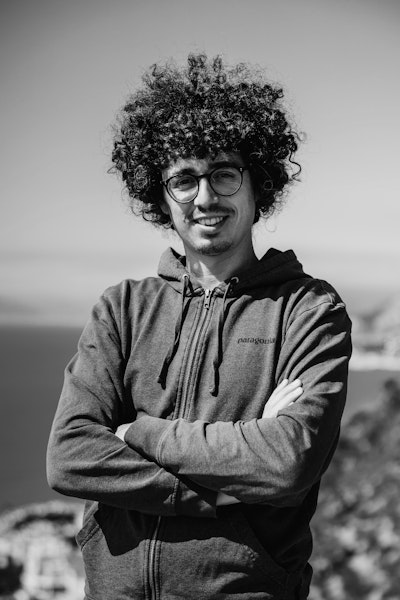
Photos
Nicola Damonte
Cycled with us
Donato Cafarelli, Michele Pelacci
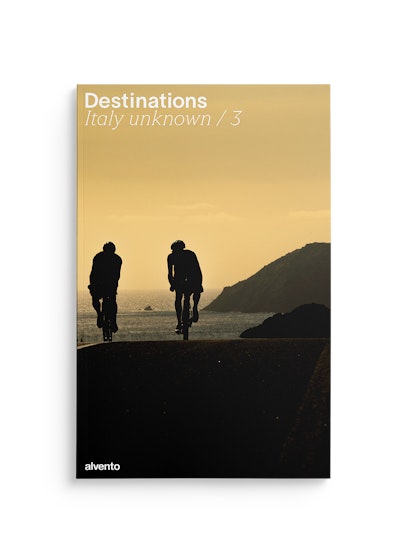
This tour can be found in the super-magazine Destinations - Italy unknown / 3, the special issue of alvento dedicated to bikepacking. 9 little-trodden destinations or reinterpretations of famous cycling destinations.
